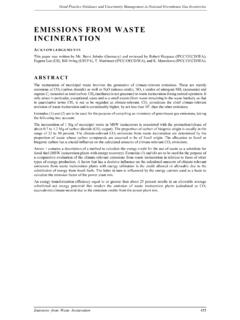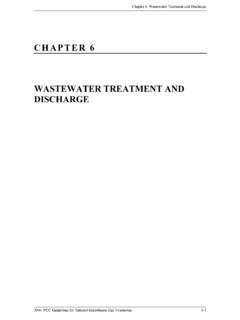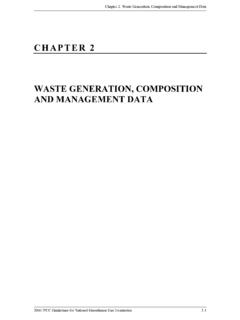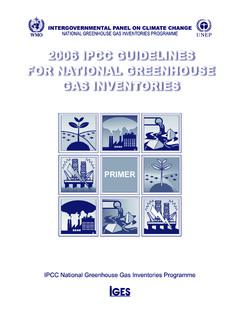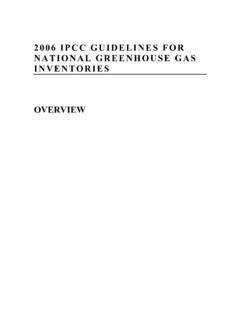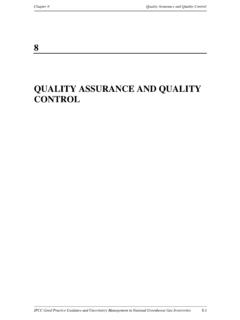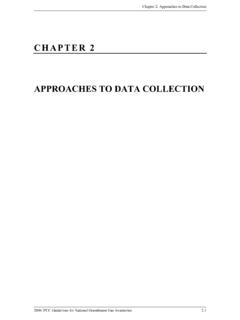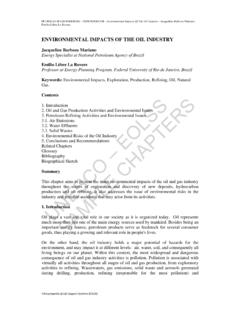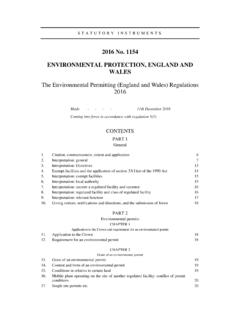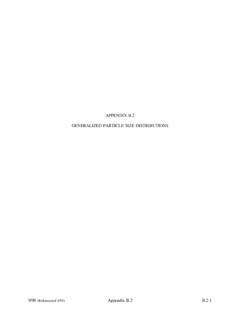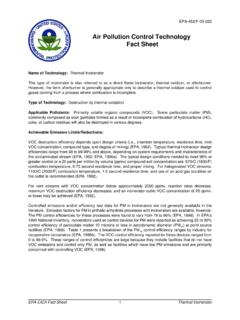Transcription of CHAPTER 2 WASTE GENERATION, COMPOSITION AND …
1 CHAPTER 2: WASTE generation , COMPOSITION and Management Data CHAPTER 2. WASTE generation , COMPOSITION . AND MANAGEMENT DATA. 2006 IPCC Guidelines for National Greenhouse Gas Inventories Volume 5: WASTE Authors Riitta Pipatti (Finland), Chhemendra Sharma (India), Masato Yamada (Japan). Joao Wagner Silva Alves (Brazil), Qingxian Gao (China), Sabin Guendehou (Benin), Matthias Koch (Germany), Carlos L pez Cabrera (Cuba), Katarina Mareckova (Slovakia), Hans Oonk (Netherlands), Elizabeth Scheehle (USA), Alison Smith (UK), Per Svardal (Norway), and Sonia Maria Manso Vieira (Brazil). 2006 IPCC Guidelines for National Greenhouse Gas Inventories CHAPTER 2: WASTE generation , COMPOSITION and Management Data Contents 2 WASTE generation , COMPOSITION and Management Data Introduction.
2 WASTE generation and management data .. Municipal Solid WASTE (MSW) .. Sludge .. Industrial WASTE .. Other WASTE .. WASTE COMPOSITION .. Municipal Solid WASTE (MSW) .. Sludge .. Industrial WASTE .. Other WASTE .. Annex WASTE generation and Management Data - by country and regional averages .. References .. Tables Table MSW generation and treatment data - regional defaults .. Table Industrial WASTE generation in selected countries .. Table MSW COMPOSITION data by percent - regional defaults .. Table Default dry matter content, DOC content, total carbon content and fossil carbon fraction of different MSW components .. Table Default DOC and fossil carbon content in industrial WASTE .. Table Default DOC and fossil carbon contents in other WASTE .
3 Table MSW generation and management data - by country and regional averages .. Boxes Box Example of activity data collection for estimation of emissions from solid WASTE treatment based on WASTE stream analysis by WASTE type .. 2006 IPCC Guidelines for National Greenhouse Gas Inventories Volume 5: WASTE 2 WASTE generation , COMPOSITION AND. MANAGEMENT DATA. INTRODUCTION. The starting point for the estimation of greenhouse gas emissions from solid WASTE disposal, biological treatment and incineration and open burning of solid WASTE is the compilation of activity data on WASTE generation , COMPOSITION and management. General guidance on the data collection for solid WASTE disposal, biological treatment and incineration and open burning of WASTE is given in this CHAPTER in order to ensure consistency across these WASTE categories.
4 More detailed guidance on choice of activity data, emission factors and other parameters needed to make the emission estimates is given under CHAPTER 3, Solid WASTE Disposal, CHAPTER 4, Biological Treatment of Solid WASTE , and in CHAPTER 5, Incineration and Open Burning of WASTE . Solid WASTE generation is the common basis for activity data to estimate emissions from solid WASTE disposal, biological treatment, and incineration and open burning of WASTE . Solid WASTE generation rates and COMPOSITION vary from country to country depending on the economic situation, industrial structure, WASTE management regulations and life style. The availability and quality of data on solid WASTE generation as well as subsequent treatment also vary significantly from country to country.
5 Statistics on WASTE generation and treatment have been improved substantially in many countries during the last decade, but at present only a small number of countries have comprehensive WASTE data covering all WASTE types and treatment techniques. Historical data on WASTE disposal at SWDS are necessary to estimate methane (CH4) emissions from this category using the First Order Decay method (see CHAPTER 3 Solid WASTE Disposal, Section ). Very few countries have data on historical WASTE disposal going back several decades. Solid WASTE is generated from households, offices, shops, markets, restaurants, public institutions, industrial installations, water works and sewage facilities, construction and demolition sites, and agricultural activities (emissions from manure management as well as on-site burning of agricultural residues are treated in the Agriculture, Forestry and Other Land Use (AFOLU) Volume).
6 It is good practice to account for all types of solid WASTE when estimating WASTE -related emissions in the greenhouse gas inventory. Solid WASTE management practices include: collection, recycling, solid WASTE disposal on land, biological and other treatments as well as incineration and open burning of WASTE . Although recycling (material recovery)1. activities will affect the amounts of WASTE entering into other management and treatment systems, the impact on emissions due to recycling ( , changes in emissions in production processes and transportation) is covered under other sectors and will not be addressed here in more detail. WASTE generation AND MANAGEMENT. DATA. Guidance on how to collect data on WASTE generation and management practices is given separately for municipal solid WASTE (MSW), sludge, industrial and other WASTE .
7 Default definitions for these categories are given below. These default definitions are used in the subsequent methodological guidance. The definitions are transparent to allow for country-specific modifications, as WASTE categorisation varies much from country to country, and can encompass different WASTE If the available data used in the inventory cover only certain WASTE types or sources ( , municipal WASTE ), this limited availability should be documented clearly in the inventory report and efforts should be made to complement the data to cover all WASTE types. In the Section WASTE COMPOSITION , default compositions are given for these default WASTE categories. The default compositions are used as the basis for the calculations for Tier 1 methods.
8 1. Recycling is often defined to encompass also WASTE -to-energy activities and biological treatment. For practical reasons a more narrow definition is used here: Recycling is defined as recovery of material resources (typically paper, glass, metals and plastics, sometimes wood and food WASTE ) from the WASTE stream. 2. Some countries do not use these broad WASTE categories but a more detailed classification, , the Regulation of the European Parliament and Council on WASTE statistics (EC no 2150/2002) that does not include municipal solid WASTE as a category. 2006 IPCC Guidelines for National Greenhouse Gas Inventories CHAPTER 2: WASTE generation , COMPOSITION and Management Data Municipal Solid WASTE (MSW). Municipal WASTE is generally defined as WASTE collected by municipalities or other local authorities.
9 However, this definition varies by country. Typically, MSW includes: Household WASTE ;. Garden (yard) and park WASTE ; and Commercial/institutional WASTE . The regional default COMPOSITION data for MSW is given in Section Default data Region-specific default data on per capita MSW generation and management practices are provided in Table These data are estimated based on country-specific data from a limited number of countries in the regions (see Annex ). These data are based on weight of wet waste3 and can be assumed to be applicable for the year 2000. WASTE generation per capita for subsequent or earlier years can be estimated using the guidance on how to estimate historical emissions from SWDS in CHAPTER 3, Section , and the methods for extrapolation and interpolation using drivers in CHAPTER 6, Time Series Consistency, in Volume 1, General Guidance and Reporting.
10 TABLE MSW generation AND TREATMENT DATA - REGIONAL DEFAULTS. MSW generation Fraction of Fraction of Fraction of Fraction of other Region Rate1, 2, 3 MSW disposed MSW MSW MSW management, (tonnes/cap/yr) to SWDS incinerated composted unspecified4. Asia Eastern Asia South-Central Asia - South-East Asia Africa5 - - Europe Eastern Europe Northern Europe Southern Europe Western Europe America Caribbean - Central America - - South America North America Oceania6 - - 1. Data are based on weight of wet WASTE . 2. To obtain the total WASTE generation in the country, the per-capita values should be multiplied with the population whose WASTE is collected. In many countries, especially developing countries, this encompasses only urban population.
